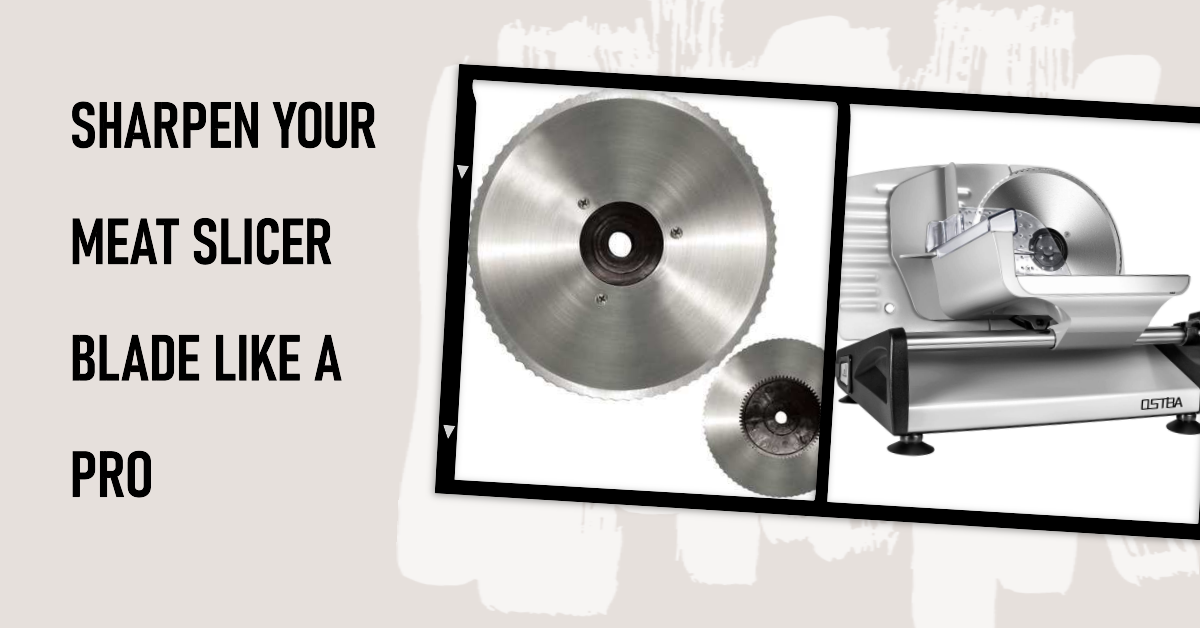A well-maintained and sharp meat slicer blade is the key to achieving consistent, thin, and precise slices of meat, cheese, and other foods in any professional kitchen or even your home. As with any sharp kitchen tool, regular use can lead to dulling, affecting both the quality of the slices and the overall performance of the slicer.
However, fear not, as in this comprehensive guide, we will walk you through the step-by-step process of sharpening your meat slicer blade like a pro. By the end of this article, you’ll be equipped with the knowledge and skills to keep your meat slicer operating at its peak performance.
Slice Smarter, Not Harder: How to Sharpen Your Meat Slicer Blade (Step-by-Step Guide):
Before we delve into the sharpening process, let’s gather the necessary tools to ensure a successful outcome:
- Meat slicer lubricant or food-grade oil: A suitable lubricant is essential to reduce friction during the sharpening process and prevent rusting on the blade.
- A screwdriver (for blade removal, if applicable): Some meat slicers allow for easy blade removal, which provides better access for sharpening.
- Soft cloth or sponge: Use a soft cloth or sponge to clean the blade thoroughly before and after sharpening.
- Honing stone or sharpening tool suitable for your slicer blade type: There are various sharpening tools available, such as honing stones, sharpening rods, and electric knife sharpeners, designed for different types of blades.
- Cleaning brush or toothbrush: A cleaning brush or toothbrush helps to remove food particles and debris from hard-to-reach areas of the blade.
- Food-safe cleaner or warm soapy water: Cleaning the blade with a food-safe cleaner or warm soapy water ensures it is free from any grease or dirt.
Once you have the essentials, let’s get started.
Step 1: Safety First
As with any maintenance procedure involving sharp tools, safety is of utmost importance. Before starting the sharpening process, ensure your meat slicer is unplugged and disconnected from the power source. This will prevent any accidental injuries while working on the blade.
Step 2: Disassemble the Blade (if applicable)
If your meat slicer allows for easy blade removal, follow the manufacturer’s instructions to disassemble the blade. This step will provide better access to the blade, allowing you to sharpen it more effectively.
Step 3: Clean the Blade
Before sharpening the blade, it’s crucial to clean it thoroughly. Use a soft cloth or sponge, along with a food-safe cleaner or warm soapy water, to remove any food particles, debris, or grease build-up on and around the blade. A toothbrush can be particularly handy for cleaning hard-to-reach areas.
Step 4: Apply Lubricant or Oil
After cleaning the blade, apply a thin coat of meat slicer lubricant or food-grade oil. The lubricant helps reduce friction during sharpening and prevents the blade from rusting over time. Apply the lubricant evenly to the entire length of the blade using a clean cloth.
Step 5: Choose the Right Sharpening Tool
Selecting the appropriate sharpening tool for your meat slicer blade is essential for achieving the best results. There are various options available, and each is designed for specific blade types. For example:
- Honing stones: These are ideal for maintaining the sharpness of an already relatively sharp blade. They are available in various grit levels, and coarser stones are used for more aggressive sharpening, while finer stones are used for polishing the edge.
- Sharpening rods: Also known as honing steels, sharpening rods are perfect for realigning and straightening the edge of the blade. They are not ideal for major sharpening tasks but are excellent for regular maintenance.
- Electric knife sharpeners: These are automated sharpening devices that offer convenience and consistency. They use rotating abrasive wheels to sharpen the blade quickly and efficiently.
It’s essential to refer to your meat slicer’s user manual or the manufacturer’s recommendations to select the best sharpening tool for your specific blade type.
Step 6: Sharpen the Blade
With the appropriate sharpening tool in hand, you are ready to start the sharpening process. It’s crucial to hold the tool against the blade at the specified angle recommended by the manufacturer. In most cases, this angle is around 20 degrees. Maintaining a consistent angle and pressure is essential to achieving an evenly sharpened edge.
If you are using a honing stone, place it on a stable surface and hold the blade at the proper angle against the stone. Glide the blade along the entire length of the stone, starting from the heel to the tip of the blade. Use smooth and even strokes, applying light pressure. Repeat this process on both sides of the blade, alternating between strokes to maintain a uniform edge.
For sharpening rods, hold the rod vertically with its tip resting on a stable surface. With the blade at the proper angle, draw the edge of the blade along the rod, from the heel to the tip. Again, apply consistent pressure and repeat on both sides of the blade.
If you are using an electric knife sharpener, simply follow the manufacturer’s instructions for proper usage. Electric sharpeners are generally user-friendly and require minimal effort.
Step 7: Test the Blade
Once you finish sharpening, it’s time to put the blade to the test. Reassemble the blade (if applicable), and plug the meat slicer back in. Test the blade by slicing a thin piece of meat. If the results are not satisfactory, repeat the sharpening process. With practice, you’ll become more proficient at achieving the desired sharpness.
Step 8: Regular Maintenance
To keep your meat slicer blade in top condition, regular maintenance is crucial. After each use, clean the blade thoroughly using a soft cloth or sponge and warm soapy water or a food-safe cleaner. Ensure the blade is completely dry before storing or using it again.
Periodically applying a light coating of lubricant or food-grade oil will prevent the blade from rusting and keep it functioning smoothly. Always store your meat slicer in a dry and clean environment, free from any moisture or dust.
Final Words
Congratulations! You’ve mastered the art of sharpening a meat slicer blade. By following this comprehensive guide, you can maintain a razor-sharp blade that ensures precise and efficient slicing in your kitchen. Remember, safety and proper maintenance are paramount, so always adhere to the manufacturer’s guidelines and use food-safe materials.
With your newly acquired knowledge, you can confidently keep your meat slicer performing at its best, saving you time and effort in your culinary endeavors. Regularly maintaining and sharpening your meat slicer blade will not only enhance its longevity but also elevate your culinary creations to a whole new level. Happy slicing!

